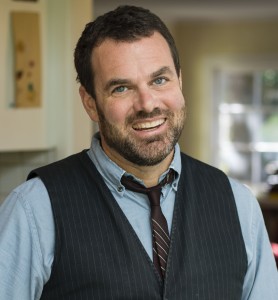Five Questions with Grant Faulkner
NANO Fiction: Your recent collection, Fissures, consists of one hundred 100-word stories. (We’re delighted to publish “Shirley Temple” from the collection issue 9.1 of NANO Fiction.) What was it like to put together a collection of 100-word stories? What advice can you give to other writers who are looking to put together a collection of flash fiction?
Grant Faulkner: It was amazingly challenging to order so many stories. I worried that there would be too many redundant themes, or that the stories would have a monotonous tone if read in succession. It was much more difficult than putting together a conventional collection of short stories, which is hard enough.
I was tempted to just toss all of the stories into the air and simply order them randomly, but I carefully and painstakingly grouped pieces that spoke to each other thematically, and then searched for ways to modulate motifs and tones.
Also, although each piece is meant to stand on its own, I have a series of stories about two tragic lovers, Gerard and Celeste, which I wove in from beginning to end to provide a guiding throughline for the collection.
My advice for other writers putting together a collection of flash? Practice making collages. This collection is a collage in the end.
NF: As the Executive Director of National Novel Writing Month, do you ever write flash fiction in November, or is it reserved exclusively for writing novels?
GF: I only write novels during November, but we put on a more casual version of NaNoWriMo called Camp NaNoWriMo in April and July. Camp invites writing projects of all types, so I once wrote 30 flash stories in 30 days, which was challenging because I had to create an entirely new story each day. There was no sense of picking up the story where I left off as there is in a novel. 
Per November, my novels often move with a flash aesthetic—I like imagining stories in a fragmented, elliptical way—so I think there’s a little flash in all of my writing. Writing flash has taught me how to move a story along by implications, and that what’s left out of a story is often more important than what’s included.
NF: What skills do you need to hit 100 words each and every time? Is it more about coming up with the perfect words? The perfect subject matter? Or is it more about writing 100 pages and then cutting out the bits you like best?
GF: You actually need the same skills to write a good 100-word story as you need to tell a good story in any form, whether it’s arresting subject matter, engaging dialogue, or telling details. I don’t think that 100-word stories have to adhere to a conventional “beginning, middle, end” story structure, but most of mine do, and most of the stories we publish in 100 Word Story possess that same trajectory. Yet, at the same time, they can reside in the blurry boundaries of a prose poem.
There’s no doubt, though, that the form is built for those who love to edit. I’d say 90% of the process is, in fact, editing. A single sentence can serve the function that a paragraph or even a chapter might in a longer work. Flaubert’s concept of the mot juste is a guiding principle with so few words to work with. The form teaches the precision of language.
I usually write a draft of anywhere between 80 and 120 words and then shave and add, shave and add, until I find the exact words for the story.
NF: Each month over at 100 Word Story (where you’re an editor), you post a photograph as a writing prompt, encourage writers to enter their stories in the comments section, and then choose one of the entries to publish. What do you think about the relationship between visual imagery and text? Do you use photos (or other forms of visual art) to come up with your own work?
GF: We do a monthly photo prompt because 100-word stories are like snapshots. That’s the way our memories work. We rarely remember something from the past in its entirety, but rather in a series of fragmentary images, or just a single image. So the photo prompt seemed appropriate.
I don’t often use prompts of any sort. I don’t know why. Two of my favorite stories were sparked by photo prompts. Perhaps it’s a defect of mine.
NF: What can we expect next from Grant Faulkner?
GF: I’m concerned with the demise of tap dancing in America, and would like to bring it back into vogue. I’m also disturbed by how spare, minimalist design is privileged these days as a lifestyle and would like to spearhead a movement dedicated to the artistry of clutter. Have you ever seen an author who doesn’t live in stacks of papers and books, whose desk isn’t decorated with odd totems? A clear mind is an unartistic mind.
Beyond that, I just finished an epistolary novel—letters from an abandoned lover that are never sent (from Gerard to Celeste, in fact). I’m working on a collection of essays on creativity that’s scheduled to be published in late 2016. I’m about to start a YA novel based on the rogue, punk rock debate team I was on in high school (we were the Bad News Bears of the Iowa debate circuit in the early 80s). And I’m trying to feed my children regularly.
